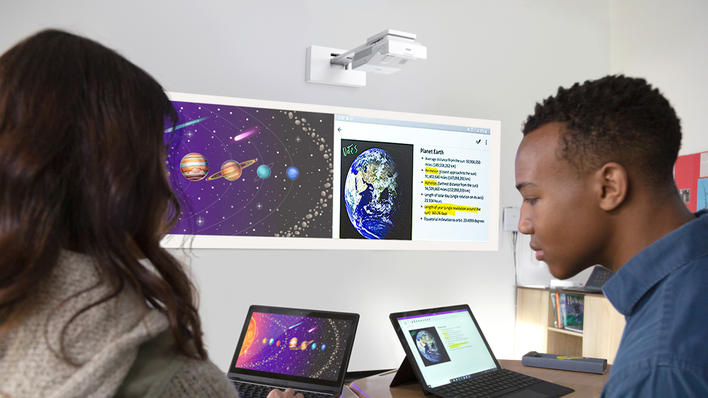As Millennials graduate from college and consider advanced degrees, West Michigan universities realize they need to integrate technology into course delivery and cater to a generation that grew up in the digital age.
With a plethora of online programs in which students aren’t as limited by place, the region’s universities are exploring ways to adjust curriculum delivery to appeal to today’s digital generation of learners and busy working professionals who desire flexibility, convenience and real-world relevance.
Colleges are adding more hybrid or blended learning courses, which combine face-to-face meetings and online learning components. Research supports its the most promising method to increase access to higher education and student learning outcomes.
“Students enrolled in the Master of Business Administration and executive MBA at Grand Valley State University tend to be older, with several years of work experience, and still appreciate meeting face-to-face,” said Diana Lawson, dean of Seidman College of Business.
“All of the classes have a component on campus and that’s deliberate; it’s what our stakeholders have said is really important,” she said. “The feedback we get from the students is they really like the interactions and discussion with the faculty and their classmates and we also bring in a lot of people from industry as speakers.”
Seidman College of Business developed a three-pronged approach to graduate studies: Know, Do, Be. Not only is it important for students to know the content and how to apply it, but the third important component is professional and personal development.
That includes experiential learning, coaching and real-world scenarios and problem solving to help students build their leadership skills.
“A lot of the knowing is done online,” Lawson said. “Whenever they come to class, we take that knowledge and apply it through case studies, discussions and hands-on projects related to the companies the students work for. Students in the executive MBA program, which meets on the weekends, are sponsored by their companies. Those earning a professional MBA are typically part-time students and early- to mid-career professionals who attend class one night a week. They also have a capstone project that usually relates to the company where they work.”
“By making this link, it helps the students to anchor the materials,” she said. “They can really understand it because they are living it.”
Seidman encourages graduate students to have at least three to five years of work experience and also offers a micro-masters for early career professionals beginning to move into management and leadership positions. All of the programs are cohort-based, meaning the same group of students starts and finishes together to encourage team building and collaborative group work.
Instructors incorporate technology into the program in various ways through the university’s learning-management system, video tutorials, Class Capture software (which essentially records the class and allows students to watch it later), and technology called Bluescape that provides teams a virtual workspace to meet, share and archive changes to projects.
Students can be in Kalamazoo, Grand Rapids and Traverse City and virtually come together to work on their projects and talk to one another.
Adding an online MBA program or more online course offerings is on the college’s radar, but right now the current delivery framework is preferred to build those soft skills such as critical thinking and communication. Business partners report the students know the content, but they don’t always have the soft skills needed for management.
“The programs have been really successful,” Lawson said. “We work closely with our sponsor companies to make sure were doing what they need.”
GVSU has 40 graduate programs currently, and each program continues to explore the best uses of technology and how to best meet the needs of today’s digital generation. Course delivery is a mix of traditional, hybrid, online, experiential and laboratory learning, said Jeff Potteiger, dean of the Graduate School at GVSU.
“As a university, we are very much aware of how important it is to stay up with technology and the learning styles of our students,” Potteiger said. “Things are so varied across this institution, and we make sure everybody has this real-world experience.”
GVSU’s Simulation Center has transformed the university’s health-care education, particularly in nursing, physical therapy, and physician assistant programs. At the center, students practice clinical skills and decision making using manikins and simulated patients.
These simulated yet real-life scenarios, ranging from starting an IV to rehab to general patient care, work to improve clinical judgment, promote patient safety, increase psychomotor skills and build students’ confidence, according to Potteiger.
“For biology or environmental courses, the best way to learn is out in rivers and streams. But for nursing or physical therapy, students need to work in a clinical environment and get hands-on experience,” he said.
GVSU is committed to giving students the graduate programs and courses they want, in a format they want, but educational technology remains the only fully online program, Potteiger said. “The growing challenge for instructors is to keep students moving and actively engaged.”
“They like to still be able to interact with an instructor, they like to be able to get instantaneous feedback from that person in the room, he said. I’ve done this for a long time, I’ve seen a lot of things tried, and some things work and some things just don’t work online.”
At Western Michigan University, the Graduate College has started to partner with four-year liberal arts colleges and offer more accelerated programs and combined degree programs, said Sue Stapleton, interim provost and dean.
WMU’s Haworth College of Business is looking to combine an MBA with other programs; for instance: aviation, engineering or medicine so students can learn the business side of a specialized skill or industry.
“Combined-degree programs cost less than two degrees would cost separately and they reduce the time commitment for the student. Ultimately, the goal is to provide the education and skills that individuals need to be successful in their professions,” Stapleton said.
“We need to think about our constituents and how do we best serve them and deliver the great education we know were in the business of doing,” she said. “It’s about meeting the students where they are at in terms of their particular needs and also understanding what the workforce is asking.”
Besides online and hybrid delivery, WMU has some open-ended learning offerings, and courses that are condensed or meet over a few weekends. WMU also offers several online graduate programs to help working professionals fit graduate education around their work, family and home life and attract students beyond the region.
“Our reach is beyond just the West Michigan area and we know we have a lot of great programs so were taking our programs to them,” she said.
It’s not just area business schools that are adjusting curriculum, offering hybrid classes and exploring ways to best meet the needs of digital and remote learners. Fueled by research and innovation, educational technology programs stand on the cutting-edge of integrating technology into the classroom.
At Michigan State University, pioneering research in robot-mediated learning found enhanced student engagement in hybrid courses. Online students who used the robots said they felt more connected to the instructor and other students in the classroom, and the study found more benefits with the robot than with traditional video-conferencing.
“When students log in using Skype or Zoom, they often feel afraid to speak up in class. As well, multiple students are displayed on a single screen, preventing instructors from giving virtual students one-on-one visual attention,” said Christine Greenhow, associate professor of educational psychology and educational technology for MSU’s College of Education.
MSU’s College of Education Design Studio developed the robot technology. Greenhow has since introduced the robots in her blended doctoral courses, leading to a research study and the 2017 AT&T Award for helping all students learn through inclusive, technology-assisted teaching.
Greenhow teaches several courses with a mix of students in the on-campus doctoral program and the hybrid program who join class via video conferencing or the robots. The remote students log on to the robots and can physically move them around the room or pan around the room to see and talk with their classmates. “It helps to be able to look a robot learner in the eye, at least digitally,” Greenhow said.
Robotics technology, especially for classes where a discussion-based approach is the main pedagogy, is likely the wave of the future, according to Greenhow. Online learning and hybrid programs continue to grow, but there are still problems with them, including higher dropout rates and challenges with online-student engagement.
“As long as there are teaching problems, well be searching for solutions to them,” Greenhow said. “In graduate education especially, I think this could offer some opportunities to improve online learning in some areas where it’s typically been weak.”
Greenhow teaches Ph.D. students in their mid 20s to late 30s and emphasizes the importance of establishing an online identity, whether they want to go into STEM or academia or research. In some courses, she has students develop a Twitter identity in which following and daily tweeting are part of their grades.
Her goal is to get them to use social media to help advance their careers by building a network and establishing a reputation as a scholar or expert. Many employers also expect employees to have a digital identity or to use social media in a professional setting, and students may lose out on a job if they don’t come up in an internet search.
“I encourage students to be thoughtful about building their online identity and their online networks,” she said. “I see them realizing its potential for their work and using these tools for their advantage.”
Another trend in higher education — to be both environmentally and fiscally responsible and appeal to this digital generation — is to use learning management systems for course documents, assignments, tests and grades.
Most of Greenhow’s courses are virtually paperless. Students access course materials and readings through a dedicated website and submit assignments and view their grades online. Today’s students have grown up with technology and expect to work through their phones or computers, she said.
While there is a learning curve among individual professors and instructors to get on board with technology, it’s important they model responsible uses of technology and teach students how to deploy it.
“They’re on technology all the time, they’re reading online and that’s typical of their way of working,” she said. “I think the students expect it, they expect us to integrate these technologies and make things digitally available.”
On the flipside, instructors say some student use of technology is superficial and they aren’t as savvy as adults might think. When it comes to Excel or navigating requirements for an online course, they often need additional training and guidance.
“Students are good at texting and social media, but they don’t necessarily know how to learn online yet,” said Susan Hojnacki, assistant professor of education and instructional design liaison at Aquinas College in Grand Rapids. “The responsibility falls a lot more on the learner. They have to budget their time, spend the extra time outside of class interacting in online discussion forums, using online tools to share their information.”
Colleges also find students don’t understand issues of privacy and copyright and how to evaluate and verify information they find online. With information so readily available, and students turning to the internet to write papers and find sources, it’s important they know how to decipher whether what they read is truthful, reliable and current.
“One of the things we have to do is teach them to verify the accuracy of the knowledge,” GVSU’s Potteiger said. “We have to teach them how to critically evaluate the information they might pull off a website.”
Aquinas College offers graduate programs in education, management and counseling. While most meet in the traditional sense, the college is adding more hybrid and online courses. It also gives working professionals some flexibility to take a class or two.
“We are attempting to put more of our summer courses online because we know our students aren’t always physically on campus in the summer,” Hojnacki said.
Aquinas wants to create a sense of community and get students involved on campus, especially undergraduates, but hybrid or blended courses are on the rise. Instructors also have freedom to integrate technology the students are already using into class activities.
“They may watch a video at home and do more interactive work with their classmates and professor during class time, so they aren’t just sitting and listening but using the knowledge in an active way,” she said.
This month, Aquinas adjunct professor Stefani Boutelier led an introductory training on Google Certification for Education for preservice teachers, in-service teachers and faculty.
School districts increasingly use Google G Suite apps for education, and teachers can get certified in the technology. The training and online training resources are free, and the certification tests have a minimal fee.
“Collaboration is huge when you start embedding technology into the course,” she said. “It allows students and teachers to collaborate live. They can be collaborating on a paper or notes, versus sending things back and forth.”
Boutelier, an adjunct professor at both Aquinas and Davenport University, also uses online tools and technology in her classes, including Google Classroom. The key is to find ways to make technology meaningful and purposeful and enhance learning in some way, she said.
Google Classroom is a free service for schools that saves time and paper and allows instructors and students to connect, making it easy to create, distribute and grade assignments, communicate and stay organized. It’s accessible on a student’s phone, tablet or computer.
“With my pre-service teachers, I demonstrate how (Google Classroom) would work and how they might be able to use that,” she said. “They’re not only using it as a student, but they learn how to use it as a teacher, so it’s creating and redefining how they are learning as a student, too.”
She said it’s important to set boundaries in the classroom and make sure students understand there is a time for technology and a time to pay attention and engage.
“Yes, technology is amazing and we can create and redefine our environment, but we still need that human interaction and everything does not need to revolve around technology,” she said. “I think that is the biggest challenge for both sides, for the instructors and students, understanding those boundaries and making the class as purposeful as it can be.”
© 2018 Global Data Point. All Rights Reserved. Provided by SyndiGate Media Inc. (Syndigate.info). This article was from Education Monitor Worldwide and was legally licensed through the NewsCred publisher network. Please direct all licensing questions to legal@newscred.com.
![]()



